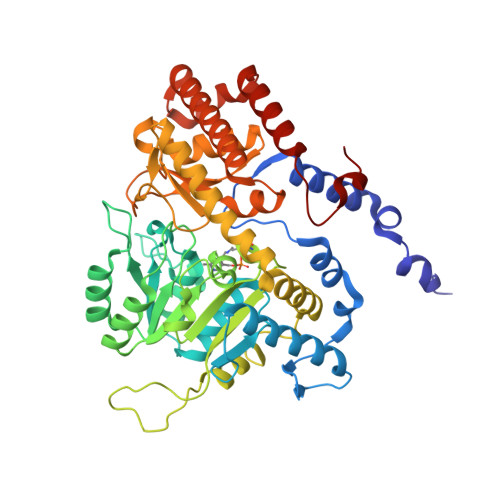Arabidopsis thaliana serine hydroxymethyltransferases: functions, structures, and perspectives.
Nogues, I., Sekula, B., Angelaccio, S., Grzechowiak, M., Tramonti, A., Contestabile, R., Ruszkowski, M.(2022) Plant Physiol Biochem 187: 37-49
- PubMed: 35947902
- DOI: https://doi.org/10.1016/j.plaphy.2022.07.025
- Primary Citation of Related Structures:
7PZZ, 7Q00, 7QPE, 7QX8 - PubMed Abstract:
Serine hydroxymethyltransferase (SHM) is one of the hallmarks of one-carbon metabolism. In plants, isoforms of SHM participate in photorespiration and/or transfer the one-carbon unit from L-serine to tetrahydrofolate (THF), hence producing 5,10-CH 2 -THF that is needed, e.g., for biosynthesis of methionine, thymidylate, and purines. These links highlight the importance of SHM activity in DNA biogenesis, its epigenetic methylations, and in stress responses. Plant genomes encode several SHM isoforms that localize to cytosol, mitochondria, plastids, and nucleus. In this work, we present a thorough functional and structural characterization of all seven SHM isoforms from Arabidopsis thaliana (AtSHM1-7). In particular, we analyzed tissue-specific expression profiles of the AtSHM genes. We also compared catalytic properties of the active AtSHM1-4 in terms of catalytic efficiency in both directions and inhibition by the THF substrate. Despite numerous attempts to rescue the SHM activity of AtSHM5-7, we failed, which points towards different physiological functions of these isoforms. Comparative analysis of experimental and predicted three-dimensional structures of AtSHM1-7 proteins indicated differences in regions that surround the entrance to the active site cavity.
- Research Institute on Terrestrial Ecosystems, Italian National Research Council, Monterotondo Scalo, Rome, Italy.
Organizational Affiliation:



















